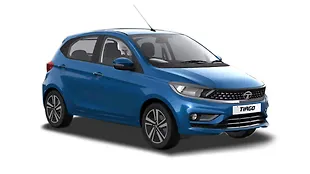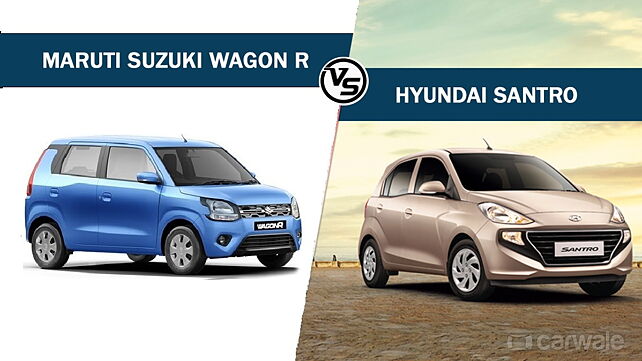
After, what feels like an eternity, Maruti Suzuki has given us an all-new Wagon R. The new-gen Wagon R comes with a whole new design as it moves to the lighter Heartect platform. And now, for the first time, it also gets a bigger 1.2-litre petrol engine. The Wagon R has become a household name in the country and it is a formidable car in its segment. However, this segment also witnessed a resurgence of another iconic moniker recently. The Hyundai Santro made a comeback after a decade of absence in the country. So now that we have two challenging names competing in the highest volume segment of the Indian market, let us have a detailed look at how they both vie against each other on paper.
Exterior and Styling:

Of the two cars we have here, the Wagon R appears to sport a mature design. It retains its characteristic tall-boy profile but the new face has undergone a comprehensive change to look more likeable and handsome. The dual-split headlamps flanking a new grille and aa simpl front bumper makes the fascia appear rather Japanese. The floating C-pillar is complemented with elongated taillights but the squared-off rear gives the new Wagon R a boxy stance.

The Santro, on the other hand, has a very debatable face. The gaping grille might not be of everyone’s liking and the tear-drop shaped headlights gives the Santro an ambivalent appeal. In profile, the fender creases and kink on the rear windows add a distinct flair to the Santro, while the rear has a curved tailgate and sculpted bumper.

Dimensionally, the Wagon R has a 35mm longer wheelbase than the Santro and is taller by 115mm. But the Santro is wider than the Wagon R by 25mm. On the other hand, the boot space of the Wagon R is more at 341 litres over Santro’s 235 litres. But both cars sit on 14-inch steel wheels (no alloys).
Interior and Features:

Similar to exteriors, the cabin of the new Wagon R is a huge leap over the older car. The dual-tone dash has a large infotainment screen atop the centre console flanked by vertical air-con vents. The new steering wheel has mounted controls and the instrument cluster has a big circular speedometer. The gear lever is mounted on the centre console. Features-wise, the new Wagon R comes with adjustable steering, remote keyless entry, all four power window, electric ORVMs, rear defogger, passenger airbag, and SmartPlay studio infotainment system.

The cabin of the Santro has an ergonomic layout but the centre placed window switch takes time to get used to. Then elements like the sporty instrument cluster and the turbine shaped side air-con side vents lends it style. The highlight of the dashboard though is the res seven-inch touch screen infotainment system which is the best-in-segment. There is the best-in-class knee room at the back row with AC vents. In terms of features, the Santro does come with reverse parking sensors, reversing camera, keyless entry, and power windows. But it misses out on steering or seat height adjust.
Engine and Transmission:
The Wagon R, for the first time, has two engine options. This includes the existing 1.0-litre 67bhp/90Nm three-cylinder engine and the larger 1.2-litre 82bhp/113Nm four-cylinder petrol motor from the Swift and the Ignis. Both engines are available with five-speed manual and AMT gearbox options.
Meanwhile, the Hyundai Santro is offered with a 1.1-litre petrol engine which is a four-cylinder unit producing 68bhp and 101Nm. Hyundai also offers a factory-fitted CNG variant in which the output is 58bhp/101Nm. Both versions get a five-speed manual as standard but the petrol versions also gets a five-speed AMT.

![Maruti Suzuki Wagon R [2019-2022] Image Maruti Suzuki Wagon R [2019-2022] Image](https://imgd.aeplcdn.com/272x153/n/cw/ec/34467/wagonr-exterior-right-front-three-quarter-3.jpeg?q=80)
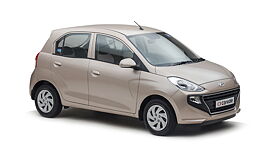

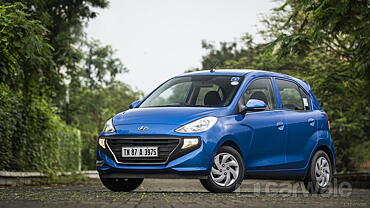

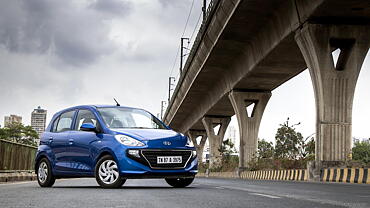




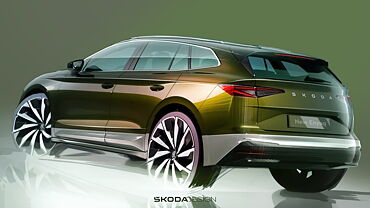


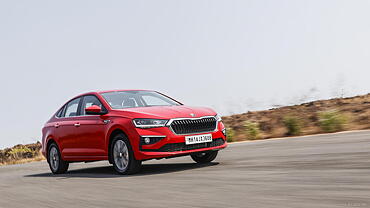



![Maruti Suzuki Wagon R [2019-2022] Right Front Three Quarter Maruti Suzuki Wagon R [2019-2022] Right Front Three Quarter](https://imgd.aeplcdn.com/199x112/n/cw/ec/34467/wagonr-exterior-right-front-three-quarter-3.jpeg?q=80)
![Maruti Suzuki Wagon R [2019-2022] Right Front Three Quarter Maruti Suzuki Wagon R [2019-2022] Right Front Three Quarter](https://imgd.aeplcdn.com/199x112/n/cw/ec/34467/wagonr-exterior-right-front-three-quarter-2.jpeg?q=80)
![Maruti Suzuki Wagon R [2019-2022] Right Side View Maruti Suzuki Wagon R [2019-2022] Right Side View](https://imgd.aeplcdn.com/199x112/n/cw/ec/34467/wagonr-exterior-right-side-view.jpeg?q=80)
![Maruti Suzuki Wagon R [2019-2022] Dashboard Maruti Suzuki Wagon R [2019-2022] Dashboard](https://imgd.aeplcdn.com/199x112/n/cw/ec/34467/wagonr-interior-dashboard.jpeg?q=80)
![Maruti Suzuki Wagon R [2019-2022] Steering Wheel Maruti Suzuki Wagon R [2019-2022] Steering Wheel](https://imgd.aeplcdn.com/468x263/n/cw/ec/34467/wagonr-interior-steering-wheel.jpeg?q=80)



